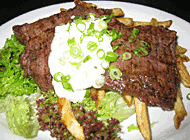Selection and storage
Horseradish root is harvested by late fall when its leaves are killed by the frost. You may also want to buy fresh roots from the markets during this season.
Select fresh, stony hard root that is devoid of sprouts, mold, or soft spots. Avoid green-tinged roots, as they are very bitter. Also, avoid overmature, old, and larger roots, as they tend to be excessively fibrous and thus, off-flavored.
Once at home, store the root in a loose paper pack and place it in the refrigerator where it will remain dormant for the next 6-9 months. Commercially prepared horseradish products can be readily available in stores all around the year.
Preparation and serving methods
Fresh root has a beige exterior color. Clean it using a moist cloth to remove surface dirt as you do it for ginger. Wash gently in cold water and mop it dry. Cut the root from the tip end as much part as you may require for your family that should last for 2-3 days. Keep the unused root inside a loosely wrapped plastic bag in the refrigerator to prevent it from drying out.
To prepare, freshly grated horseradish root is mixed with white vinegar in a desired manner to control (stabilize) its hotness. This preparation, however, gradually loses its flavor with time and turns off-white to brown color even if you keep it in cold storage.
The pungency and hotness of horseradish may not be appreciable in the whole root. However, crushing or grating the root (as in onion and radish,) releases the volatile allyl-isothiocyanate compound that can cause irritation to eyes, skin, mucosa of nose, and throat.
Vinegar or citric acid neutralizes pungency and stabilizes its flavor. Add 2 to 3 tablespoons of white vinegar and 1/2 teaspoon of table salt to one cup of grated horseradish. If you desire a milder taste, then add vinegar 1-2 minutes later.
Like in many other spices, horseradish also loses its flavor instantly. To keep the fragrance and flavor intact, it is grated just before preparing dishes and added to the cooking recipes in the final stages.
Here are some serving methods:

|
| Steak with horseradish cream and french fries. Photo: jeffreyallen |
-
Horseradish is one of the traditional spices that is relished even today in the countryside. Fresh root grated directly on the recipes to add special jest.
-
The root is used in many preparations, including dips, dressings, salads, and sauces as an accompaniment to meat, chicken, and seafood.
-
Horseradish sauce with cream is a perfect accompaniment to steak, venison, and fish like mackerel, tuna, and smoked trout.
Safety profile
Horseradish can cause irritation to skin, mucosa, and eyes. It is due to the release of allyl sulfide gas (allyl-isothiocyanate) while chopping, crushing, or grating the root. Disruption of the cell wall activates the enzyme myrosinase which when reacts with glucosinolates to form allyl isothiocyanates. Lemon citrus or vinegar stops this reaction and stabilizes the flavor. Its effect can be minimized by using a blender/mixer in a well-ventilated place and wearing protective gloves and a mask. (Medical disclaimer).
You may also like to read ≻≻-Wasabi nutrition facts and Health benefits..
≻≻-Back to Spices from Horseradish. Visit here for an impressive list of healthy spices with complete illustrations of their nutrition facts and health benefits.
≻≻-Back to Home page.
Further reading:
-
Horseradish Information Council. (opens in a new window).

